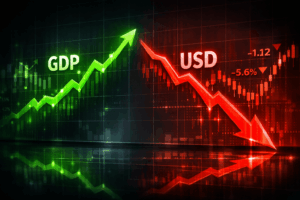Daily News Nuggets | Today’s top stories for gold and silver investors
November 13th, 2025
End of Government Shutdown Lifts Gold on Rate-cut Hopes
The U.S. government shutdown that began in October just ended, lifting gold as markets bet on easier Fed policy ahead. With President Trump signing the funding bill, the flow of delayed economic data — employment figures, inflation metrics, GDP updates — will finally resume. That matters because the Federal Reserve relies on this data to guide its next interest-rate decisions.
The return of hard numbers could give the Fed more confidence to pivot toward rate cuts, especially if the data shows cooling inflation or labor-market softness. Lower rates tend to weaken the dollar and reduce the opportunity cost of holding non-yielding assets like gold and silver. While the shutdown-driven uncertainty premium may fade, the underlying safe-haven demand remains intact as investors watch how the Fed responds.
But the shutdown’s end doesn’t mean a clean slate for policymakers.
Data Vacuum from the Shutdown Clouds Fed Decision-making
Even though the shutdown is over, the damage to economic visibility isn’t. Some key data — particularly the October jobs report and certain inflation metrics — may be permanently lost or too compromised to publish. The Bureau of Labor Statistics warned that survey response rates dropped sharply during the shutdown, making some datasets unreliable.
That leaves the Federal Reserve making decisions with incomplete information. Without clear signals on employment and inflation, the Fed may take a more cautious approach — or lean more heavily on lagging indicators. For investors, that uncertainty often translates into stronger demand for tangible assets like gold and silver, which don’t depend on Washington’s data releases to hold value. Less clarity from policymakers can mean more support for the safe-haven trade.
That Fed uncertainty is already showing up in markets.
Gold Hits New Short-term Highs As Interest Rate Outlook Shifts
Gold just capped its fifth straight session of gains, climbing to a more than three-week high around $4,207 per ounce. Analysts point to a weaker dollar, growing expectations of Fed rate cuts, and steady central-bank buying as the main drivers behind the rally.
What’s behind the latest jump? The dollar has softened as traders price in a higher probability of Fed easing later this year. Meanwhile, central banks — particularly in emerging markets — continue accumulating gold as a reserve hedge. Together, these dynamics suggest investors are positioning for a monetary-policy pivot that could compress real yields—the key metric that determines gold’s attractiveness versus bonds.
The Fed’s direction matters even more now as key leadership positions open up.
Atlanta Fed’s Bostic to Retire as Trump Presses for Rate Cuts
Raphael Bostic, president of the Federal Reserve Bank of Atlanta since 2017, announced Wednesday he’ll retire when his term ends on February 28. The departure creates a vacancy on the Fed’s policy committee at a politically sensitive moment, with President Trump openly criticizing Chair Jerome Powell and demanding faster rate cuts.
Bostic’s successor will be chosen by the Atlanta Fed’s board but must be approved by the Fed’s Board of Governors — three of whom were appointed by Trump. That gives the administration indirect influence over the pick, even though regional Fed banks are designed to operate independently. Any dovish shift in Fed leadership could accelerate the pace of rate cuts, which would likely weaken the dollar and support gold and silver prices. Bostic’s successor won’t vote on rates until 2027, but the appointment signals the Fed’s direction at a pivotal time.
While the Fed debates rate policy, inflation’s long-term impact is visible in unexpected places.
The Penny’s Final Press: When Currency Costs More Than It’s Worth
After 238 years, the U.S. Mint struck its last circulating penny on Wednesday at the Philadelphia facility. President Trump ordered the halt back in February after production costs climbed to nearly four cents per coin—almost four times its face value. The Treasury expects to save $56 million annually, though pennies will remain legal tender indefinitely.
The rollout has been messy: Retailers received no federal guidance on rounding transactions, banks began rationing supplies, and some stores are offering free drinks in exchange for piles of pennies. It’s an ironic moment for precious metals investors: while the government phases out its lowest-denomination coin because inflation has rendered it economically obsolete, gold and silver continue rallying to record highs. The penny’s demise is a tangible reminder of currency debasement—and why investors turn to assets that can’t be minted into irrelevance.






